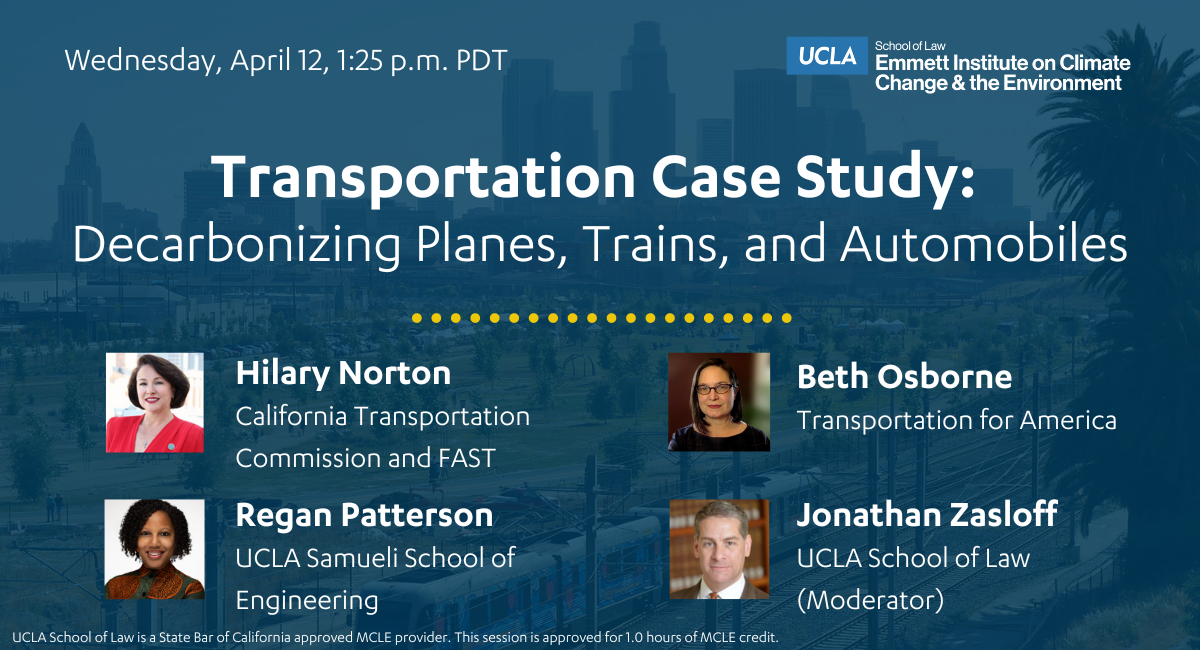Can the New Climate Laws Transform our Transportation Infrastructure?
The IIJA and IRA will spend a lot of money on transportation—but whether they’ll create fundamental change in our infrastructure or continue business as usual will depend on how that money is used.

This is the last in our series of posts previewing the Emmett Institute’s 2023 Symposium, coming up on April 12. Check out the first post, introducing some of the big questions around the IIJA and IRA, the second post, on transmission infrastructure, and RSVP for the Symposium here!
Transportation is one of the most complicated and urgent areas of the clean-energy transition. The sector—including personal transportation like passenger cars, as well as air, marine, and surface goods and people movement—is the largest source of greenhouse gasses in the U.S.: It makes up about 27% of our emissions, beating out both power generation (25%) and industrial manufacturing (24%). Eliminating those emissions presents unique challenges, including the fact that they come from many small sources, rather than a few large power plants or factories, and that those sources are mobile by definition, making it more difficult to connect them to new, clean sources of power.
For many of us, transportation is also closely tied to our everyday lives in a way that few other sources of emissions are. Many (92%) U.S. households have a car, more than own the home they live in (65%) or have someone working (79%). While we don’t usually see where our electricity comes from, we are often physically inside the sources of transportation emissions, be they cars, buses, or planes. On top of that, transportation policy defines much of our experience of the world: by design, the places that we live and spend time are shaped around transportation, determining the things we can do and even the people we know.
The transportation sector is a major focus for the Infrastructure Investment and Jobs Act (IIJA) and the Inflation Reduction Act (IRA), which, by one estimate, provide a combined $700 billion in related programs. The IIJA provides the bulk of its funding ($361 billion) to programs for building and repairing road infrastructure, although it also includes money for local transit programs ($92 billion), railways ($68 billion), and other transportation-related programs. The IRA has far less transportation funding, but a greater focus on emissions reductions: It provides about $42 billion in grants, loans, and tax credits to support clean-vehicle and battery manufacturing and, perhaps most famously, tax credits valued at $12.5 billion for people and businesses who buy electric vehicles.
How far all this funding will go toward transforming our transportation sector—and in what direction—will be the subject of our third symposium panel, Transportation Case Study: Decarbonizing Planes, Trains, and Automobiles. Let’s take a look at some of the key questions.
Private or Public Transportation?
The IIJA’s and IRA’s focus on private vehicles, rather than public transit, was a big disappointment for many transportation activists. While much of the IIJA highway funding could be used for public transit or adding bike or pedestrian lanes, the focus is on driving. Similarly, some of the stimulus for electric-vehicle and battery manufacturing could support clean busses or other public transportation, but the thrust of the program is toward electrifying private vehicles and goods movement.
This money is badly needed to both promote clean vehicles and for our aging highway infrastructure. But, as our panelist Beth Osborne has argued, greenhouse-gas reductions will also depend on reducing the amount of driving we do in general. Indeed, transportation emissions have steadily increased, despite vehicle technology increasing mileage per gallon, because people drive more and more miles each year. For this reason, many are advocating for policies that will cut down on driving generally, in addition to investing in emissions-reduction technology for when we do need our cars.
In fact, there’s some concern that the IIJA highway funding could increase greenhouse-gas emissions, because of “induced demand.” Induced demand is the tendency of urban highway expansion—in the form of new lanes, extensions, or new highways—to encourage more people to drive, which can eventually lead to that have as much traffic as before the expansion, but higher emissions. Because of induced demand, some analysts estimate that IIJA funding, depending on how it is spent, could result in anywhere from a 1.3% decrease to a 1.6% increase in transportation emissions.
Who Will Benefit?
As our panelist Regan Patterson has noted, the history of transportation policy in the United States includes harmful and racist policy decisions. Much of our transportation infrastructure was built through existing neighborhoods—often those of Black, Brown, and poor people—leading to mass displacement and the destruction or transformation of communities. And, as with many racist policies, the past isn’t past: our highway infrastructure still imposes inequitable pollution and safety burdens and divides communities.
The IIJA and IRA take some small steps toward fixing these errors. The IIJA includes $1 billion for the Reconnecting Communities Pilot, which would provide grants for removing or rerouting existing freeways in order to create more usable public space and improve safety and environmental health. The IRA expands on that program with $3 billion in Neighborhood Access and Equity Grants, which can be used for highway removal or relocation, as well for other projects, such as bike lanes, pedestrian walkways, or affordable local transit.
Shifting our transportation system away from cars could improve racial and economic equity alongside greenhouse-gas reductions. In addition to the unequal impacts of air pollution from highways, people of color and people in poverty are less likely to have access to private transportation than other groups, meaning that highway improvements themselves can be of differential benefit. Conversely, investments in public transit and walkable/bikeable cities could help make transportation more equal—if done carefully.
Who Decides?
Crucial to the implementation of IIJA and IRA is the question of who controls the money they provide for transportation. Because of how the programs are designed, the bulk of this funding will be handled by the states: as noted above, even the IIJA highway funding can be used for non-car transit options, if the recipients decide to do that. The federal government has tried to promote safety, access, and environmental programs, but has limited authority to do so, and local governments likewise have very little control over how highway funds are used (other than the grant-based programs like the Reconnecting Communities Pilot and Neighborhood Access and Equity Grants).
There are signs that some states will take advantage of the flexibility they have. Our panelist Hilary Norton, a member of the California Transportation Commission, has said that California is “not going to do highways as usual” with its share of the highway funding. And the state has indicated an interest in using IIJA funds to support its existing Active Transportation Program, targeted at “disadvantaged communities.”
The Reconnecting Communities Pilot, under IIJA, and Neighborhood Access and Equity Grant Program, under IRA, also provide opportunities for local governments to push projects forward. A number of governments have already developed projects and received awards under the Reconnecting Communities Pilot, including two projects here in the LA area. The federal Department of Transportation is still working on the IRA program, which is scheduled to launch in the next few months.
Road Work Ahead
Wherever the money ends up, the IIJA and IRA represent a massive investment in transportation infrastructure and clean vehicles. The $700 billion will likely be an important step toward reducing emissions in this sector, not to mention fixing our roads, tunnels, and bridges. But reaching the full, transformative potential of these new climate laws will depend on an enormous number of decisions being made right now, in state transportation offices across the country.








Reader Comments